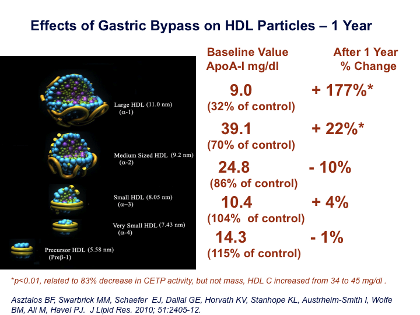Schaefer - Figure 12 - Gastric bypass on HDL Text
Given the association of overweight and obesity with these deleterious HDL particle profiles, a logical question would be what happens when a patient experiences significant weight loss? The most striking examples of this are with bariatric (gastric bypass) surgery. As seen in the Figure, following bariatric surgery, serum HDL cholesterol increases from about 38 to 45 mg/dL, but more impressive is a massive rearrangement of the HDL particle size spectrum. Here, consistent with a significant decrease of CHD risk following significant weight loss, there is almost a doubling (a 177%) increase in the large (alpha1) HDL particles. (Although not shown here, this increase in the larger HDL particles is actually due mainly to a reduction in the activity, rather than the mass, of CETP.)
J Clin Lipidol. 2011; 5(6).